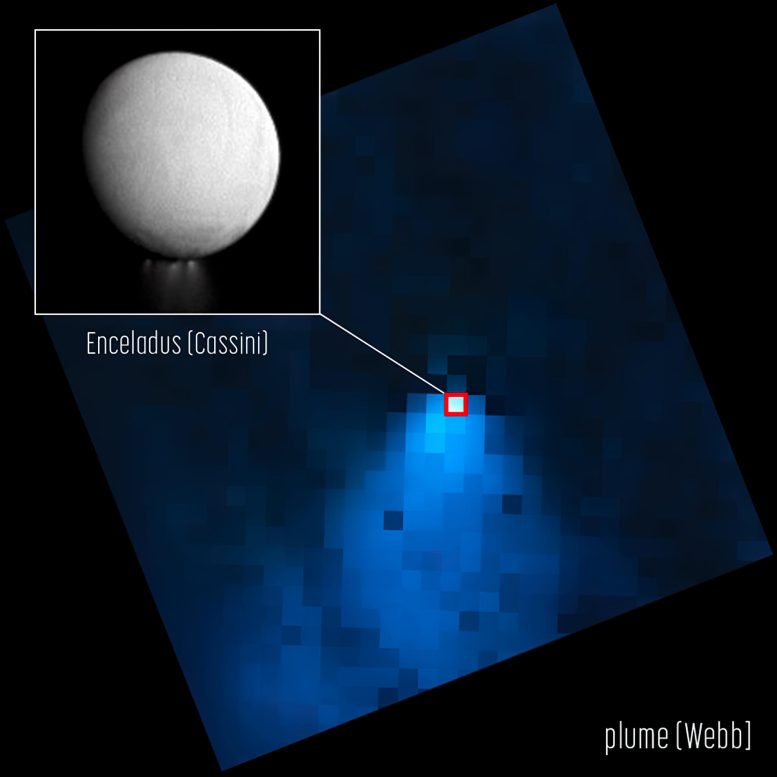
SwRI contributed to new Cycle 1 JWST findings that show the plume of water escaping from Saturn’s moon Enceladus extends 6,000 miles or more than 40 times the moon’s size. In light of this discovery, SwRI’s Dr. Christopher Glein was awarded a NASA JWST Cycle 2 allocation to study the plume as well as the icy surface of Enceladus, to better understand the potential habitability of this ocean world. Credit: NASA/ESA/CSA/Alyssa Pagan (STScI)/Geronimo Villanueva (NASA-GSFC)
SwRI scientist awarded JWST Cycle 2 observations of Enceladus
A pair of scientists from the Southwest Research Institute (SwRI) were members of a James Webb Space Telescope (JWST) team that observed a towering plume of water vapor stretching over 6,000 miles — a distance comparable to that between the U.S. and Japan — erupting from the surface of Saturn’s moon, Enceladus. This notable discovery, achieved during NASA JWST’s Cycle 1, has led to Dr. Christopher Glein of SwRI being granted a Cycle 2 allocation to examine both the plume and crucial chemical compounds on the surface, in an effort to better comprehend the possible habitability of this oceanic celestial body.
During its thorough 13-year survey of the Saturnian system, the Cassini spacecraft established the existence of a subterranean ocean of liquid water on Enceladus. The spacecraft analyzed samples as plumes of ice grains and water vapor erupted into space from cracks in the moon’s icy surface.
“Enceladus is one of the most dynamic objects in the solar system and is a prime target in humanity’s search for life beyond Earth,” said Glein, a leading expert in extraterrestrial oceanography. He is a co-author of a paper recently accepted by Nature Astronomy. “In the years since NASA’s Cassini spacecraft first looked at Enceladus, we never cease to be amazed by what we find is happening on this extraordinary moon.”
Once again, the latest observations made with Webb’s Near InfraRed Spectrograph have yielded remarkable results.
“When I was looking at the data, at first, I was thinking I had to be wrong, it was just so shocking to map a plume more than 20 times the diameter of the moon,” said Geronimo Villanueva of NASA’s Goddard Space Flight Center and lead author of the recent paper. “The plume extends far beyond what we could have imagined.”
Webb’s sensitivity reveals a new story about Enceladus and how it feeds the water supply for the entire system of Saturn and its rings. As Enceladus whips around the gas giant in just 33 hours, the moon spews water, leaving a halo, almost like a donut, in its wake. The plume is not only huge, but the water spreads across Saturn’s dense E-ring. JWST data indicate that roughly 30 percent of the water stays in the moon’s wake, while the other 70 percent escapes to supply the rest of the Saturnian system.
“The Webb observations, for the first time, are visually illustrating how the moon’s water vapor plumes are playing a role in the formation of the torus,” said SwRI’s Dr. Silvia Protopapa, an expert in the compositional analysis of icy bodies in the solar system who was also on the Cycle 1 team. “This serves as a stunning testament to Webb’s extraordinary abilities. I’m thrilled to be part of the Cycle 2 team as we initiate our search for new indications of habitability and plume activity on Enceladus.”
Spurred by the incredible findings from Webb’s first fleeting glimpse of Enceladus, Glein is leading the same team that will observe Enceladus again with JWST in the next year.
“We will search for specific indicators of habitability, such as organic signatures and hydrogen peroxide,” Glein said. “Hydrogen peroxide is particularly interesting because it can provide much more potent sources of metabolic energy than what we previously identified. Cassini didn’t give us a clear answer on the availability of such strong oxidants on Enceladus.”
The new observations will provide the best remote opportunity to search for habitability indicators on the surface, by boosting the signal-to-noise ratio by up to a factor of 10 compared with Cycle 1. Understanding the time variability of plume outgassing is also important to plan for future planetary science missions that target the plume.
“Webb can serve as a bridge between Cassini and the proposed search-for-life mission, Orbilander,” Glein said. “After Cycle 2, we will have a better idea if ocean samples are widely distributed over Enceladus’s surface, as opposed to just near the south pole. These next observations could help us determine if Orbilander can access ocean samples near the equator, which may help us get back to Enceladus sooner.”
Reference: “JWST molecular mapping and characterization of Enceladus’ water plume feeding its torus” by G. L. Villanueva, H. B. Hammel, S. N. Milam, V. Kofman, S. Faggi, C. R. Glein, R. Cartwright, L. Roth, K. P. Hand, L. Paganini, J. Spencer, J. Stansberry, B. Holler, N. Rowe-Gurney, S. Protopapa, G. Strazzulla, G. Liuzzi, G. Cruz-Mermy, M. El Moutamid, M. Hedman and K. Denny, 19 June 2023, Nature Astronomy.
DOI: 10.1038/s41550-023-02009-6

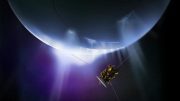
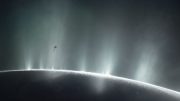
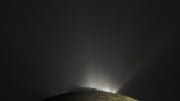
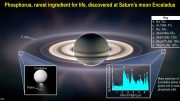
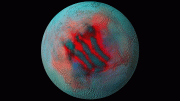
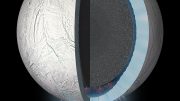
“Cassini didn’t give us a clear answer” – because it wasn’t equipped to do so. Wouldn’t it be nice if it COULD have looked for microbial life in the plumes? I still don’t understand why we fail to explore objects with a high probability for life in favor of dead rocks like Mars. It would be great to have answers on places like Europa and Enceladus in my lifetime, but it will never happen. Let’s just squint through a telescope from here and say “Sure is one heck of a water plume. Wonder if there’s any evidence of current marine life in there? Guess we’ll never know. Anyway, are those pics of rocks and dust on Mars ready? Also, DERP.” I wish a privately-funded entity would send their own probe to search for real evidence of life.
SHOULD we be landing on a probably habitable world risking contamination when that world is literlly handing us the data we claim to want?
We don’t have to land, but are going to do it anyway? Like, on the Simpsons? Or are we going to take a hands off approach to what is not ours?
Life finding missions mus by their nature see to it that they don’t contaminate what they explore.
As for life spreading, it is estimated that bodies such as Enceladus have been hit by Earth ejecta out to precisely Enceladus Saturn orbit. We are likely not doing additional harm, if any (it is hard for invasive generalist species that haven’t evolved for the new environment they meet).
Cassini’s small mass spectrometer wasn’t intended to look for organics from plumes.
We don’t know that Mars is, or was, dead which is why it has been explored, starting before the ice moon oceans were discovered. It is also closer and easier to investigate for real evidence, and tell us more on terrestrial planets.
But missions to Enceladus are now planned, such as Enceladus Life Finder.